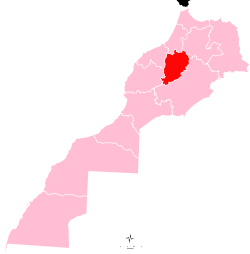Khouribga
| Khouribga | |
|---|---|
| City | |
 | |
| Nickname(s): Phosphate City | |
 Khouribga Location in Morocco | |
| Coordinates: 32°53′N 6°55′W / 32.883°N 6.917°WCoordinates: 32°53′N 6°55′W / 32.883°N 6.917°W | |
| Country |
|
| Region | Béni Mellal-Khénifra |
| Province | Khouribga Province |
| Government | |
| • Mayor | Mouhamed Zekrani (Constitutional Union, 2009) |
| • Governor | Abdellatif Chadali (2012) |
| Area | |
| • Total | 52 km2 (20 sq mi) |
| Elevation | 786 m (2,579 ft) |
| Population (2013) | |
| • Total | 210,000 |
| • Density | 4,083.46/km2 (10,576.1/sq mi) |
| • Rank | 16th in Morocco |
| Time zone | WET (UTC+0) |
| • Summer (DST) | WEST (UTC+1) |
| Postal Code | 25000 |
| Website | khouribga.com The portal of Khouribga |
Khouribga (Berber: ⵅⵯⵔⵉⴱⴳⴰ, Arabic: خريبكة) is a city in Khouribga Province in the Béni Mellal-Khénifra region of Morocco with a population of approximately 172,000. Khouribga owes its growth to the phosphate deposits nearby.
Geography
Located at least 120 km from Casablanca, 154 km from the capital, Rabat, 200 km from the city of Marrakesh, 99 km from the city of Beni Mellal and 60 km from the city of Settat, capital of Settat Province and the region Chaouia-Ouardigha which Khouribga Province belongs to. Rising 820 meters above sea level to its presence on the Phosphate plateau, also known as the Ouardigha . The city was founded in 1923 by the authorities of the French protectorate when they discovered phosphate in the region, for which Morocco is considered to be the biggest exporter in the world. There are several mines in the province, most notably the mine of Sidi Shennan near the town of Oued Zem in the Province of Khouribga, which lies 30 km from the village of Boulanouar (5 km) and the town of Boujniba (10 km) and the village of Hattane. The Province of Khouribga is bordered by the Province of Beni Mellal in the east, Province of Ben Slimane in the west, the Province of Settat in the south, and Khémisset Province in the north.
Economy
Phosphate
The Province of Khouribga has a large phosphate reserve estimated 35 to 40 billion cubic meters, which is ranked first at the national level. Also Khouribga is one of the cities that brings hard currency and that is due to its community residents from Italy.
Industrial activities
Regardless of phosphate mining, the province knew the emergence of other industries in various economic sectors:
Industrial areas
The province has three Industrial zones:
- The industrial zone of Khouribga (industrial district): 20 hectares (234 partitions) and 13 operating industrial units plus the expansion of the zone.
- The industrial zone of Oued Zem.
- The industrial zone of Bejaad.
Services
The province has several services, among them:
- 25 bank agencies
- 6 insurance agencies
- 7 travel agencies
- 2 railways with daily trips with a project to build a modern station.
Agriculture
The agricultural lands is divided into 50% arable land, 20% forests, 30% unused land. livestock is the most important source of income for the rural population, the herd is estimated to be:
- Goats: 30.000 -60.000 heads
- Equidae: 40.000 -60.000 heads
- Cows: 50.000 -70.000 heads
- Sheep: 500.000 -600.000 heads
Handicraft
The handicraft sector represents a sizable part of the local economy with 9 cooperatives (260 members), and a handicrafts association.
Health
The facilities cover most of the province with:
- 6 rooms
- 3 provincial hospitals
- 20 health centers
- 7 urban health centers
- 9 rural clinics
Twin Cities
-
 Gafsa, Tunisia.
Gafsa, Tunisia. -
 Alcamo, Italy.
Alcamo, Italy. -
 Napoli, Italy.
Napoli, Italy. -
 Poznań, Poland.
Poznań, Poland. -
 Nablus, Palestine.
Nablus, Palestine. -
 Buenos Aires, Argentina.
Buenos Aires, Argentina.
Notable people
- Alfred Beaugé (1878-1935), founder of the city.
- M'Hammed ben Omar, General Anh Ma, communist combatant in the First Indochina War.
- Koudri "Dzairi" Elhaj Ben Azouz, resistance fighter, disappeared after the 1972 events.
- Hindi Zahra, International singer.
- Hind Dehiba, née Chahyd on March 17th 1979 in Khouribga, a Moroccan-French middle-distance runner.
See also
References
External links
| |||||||||||||||||
